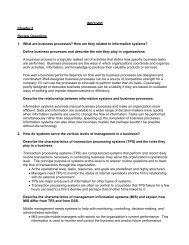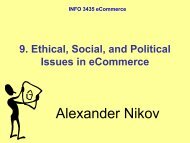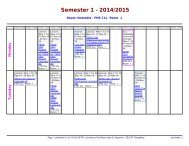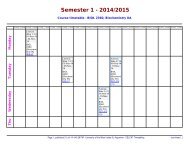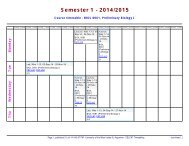INFO 3435- E-Commerce Tutorial 3 - Home
INFO 3435- E-Commerce Tutorial 3 - Home
INFO 3435- E-Commerce Tutorial 3 - Home
You also want an ePaper? Increase the reach of your titles
YUMPU automatically turns print PDFs into web optimized ePapers that Google loves.
REVIEW QUESTIONS2
1. What are the three basic buildingblocks of the Internet?• The three basic building blocks are packet switching, theTransmission Control Protocol/Internet Protocol (TCP/IP)communications protocol, and client/server computing.• Packet switching is a method of splitting messages up into parcels,routing them along available communications paths, andreassembling them at the destination point.• The TCP protocol is the set of rules that specifies how thesemessages should be formatted, ordered, compressed, and errorchecked.The IP protocol provides the addressing scheme for theInternet.• Client/server computing refers to networks of powerful clientcomputers that are connected to one or more server computers.The clients are powerful enough to display, process, and store verylarge files including graphics and sound files. The servers arededicated to common functions that all of the clients needincluding file storage, and they also house many softwareapplications and utility programs that the clients frequently use.3
2. Explain how packet switchingworks.• In packet-switched networks, messages are broken up intofragments (packets) and a digital code with the sourceaddress is attached. Sequencing and error-controlinstructions are also added.• Instead of being sent directly to their destination, the packetstravel between router computers that interconnect thethousands of networks that make up the Internet.• The routers use programs called routing algorithms toensure that each packet takes the best availablecommunication path toward its destination. If some lines aredisabled or busy, the packets can be sent along any availableline. At the destination point, the packets are reassembledand delivered. This method enables nearly full use of all of theavailable communication lines and capacity.4
3. How is the TCP/IP protocol related toinformation transfer on the Internet?• The TCP/IP protocol determines how messagesare formatted, compressed, and error-checkedand how they are addressed so that they reachthe correct destination in the correct order andformat.• TCP establishes the connections between sendingand receiving computers, and it handles theassembly of packets at the point of transmissionand their reassembly at the receiving end.• IP provides the Internet’s addressing scheme, andis responsible for the actual delivery of thepackets.5
4. Why isn’t the Internet overloaded?Will it ever be at capacity?• The Internet is not overloaded and will mostlikely not hit a capacity ceiling becauseclient/server computing is highly extensible.• Capacity can be continually expanded by addingclient computers and server computers to thenetwork. In this way, the population of Internetusers can continue to grow indefinitely.• It is also not overloaded because the Internetarchitecture is built in layers so that each layercan change without disturbing developments inother layers. On the other hand, networkconnections can reach a saturation point andslow down Internet traffic.6
5. What are some of the major technological advancementsthat are anticipated will accompany Internet II? Define anddiscuss the importance of each.• First, a bandwidth explosion fueled by fiber optic technology, willallow the Internet to move from narrowband to broadband digitalservice.• Second, wireless Web and 3G/4G technologies, will allow theInternet to move from cable-based stationary service to mobileservice.• Third, wireless LANS will allow laptop computers to be connectedto other computers, as well as to other digital devices including:home appliances, vending machines, and remote sensors.• Fourth, new Internet appliances will make it possible to connectnearly all the electronic devices in our lives to the Internet and toprivate intranets. These new Internet appliances will include thinclient computing devices (PCs without hard drives), which relytotally on the Internet server to handle all information processing.Lightweight, portable, full-function tablet PCs (similar to the iPad)and handheld devices will be able to activate and deactivatevirtually any device that can be connected to the Internet. This isexpected to include home appliances—TVs, stereos, telephones,games, security systems, cars, and netbooks—which will beinterconnected so that they can all be controlled from one source.7
6. What are at least three new services that will beavailable through the next generation of the Internet?• New services that will be available through thenext generation of the Internet include:• Digital video on demand: This is considered bymany to be a “killer app” for the future Internet.• Web distribution of software as a service willbecome increasingly prevalent.• M-commerce applications: Smartphones and tablecomputers that have the combined capabilities forvoice, data, images, audio, and video willencourage the continued development of manysophisticated mobile commerce applications inthe near future.8
Distinguish between:a) Packets and IP addressesb) Protocols and TCP/IPa)A packet is the grouping of data for transmission on a network. In technical terms; it is asequence of bits that carries identifying information for transmitting the data as well asthe data itself. A single packet contains a header to keep track of the actual data itcarries.An IP address is a host number that identifies a node or a server on a network. It iscomprised of a 32-bit string that is broken down into four octets (each octet contains 8bits).b)A protocol (in the IT arena) is a rule that governs how communication should beconducted between two parties, two computers, or a source and a destination.They are pieces of software that run on every node or computer and allow every pair ofcomputers to communicate without having to know much about each other, except forthe IP address.TCP/IP is short for Transmission Control Protocol/Internet Protocol. This is the mostwidely used protocols suite used on the Internet. TCP/IP is not restricted to the Internet;it has quickly become one of the most common protocol suites on networks.3-9
Distinguish between:c) routers and hubsA router is a piece of network hardware that operates at the Internet layer ofthe OSI model.This piece of hardware allows you to connect network segments (orsubnets), so that the different LAN segments can talk to each other. Routersare “intelligent” devices, in that they can evaluate the network traffic and canstop local traffic from entering and causing congestion on other local areanetworks. Routers are more expensive and difficult to operate than hubs.They may be slower than hubs, since they must perform additionalprocessing on the data packet.Hubs operate on the OSI physical layer. They act as a connecting point fornetwork devices. They are not “intelligent” devices, when compared torouters, and cannot perform processing on packets as they pass through thedevice. They are less expensive and easier to maintain than routers.3-10
In your own words, explain how computerscommunicate on the Internet?Walk through this process, providing the actions of the various layers of the OSI model. As thepackets travel from one node to another, they move from the uppermost layer of the OSI model downto the physical layer for transmission to the receiving node. Once the packets reach their destination,they must move back up the OSI model. The figure provides both the OSI layers as well as theTCP/IP layers (Application, Transport and Transmission).Application programFTP requestApplication layerFTPheaderFTP requestTransport layer(each packet)TCPheaderFTPheaderFTP requestInternet layer(each packet)IPheaderTCPheaderFTPheaderFTP requestNetwork accesslayerNetworkheaderIPheaderTCPheaderFTPheaderFTP request3-11




